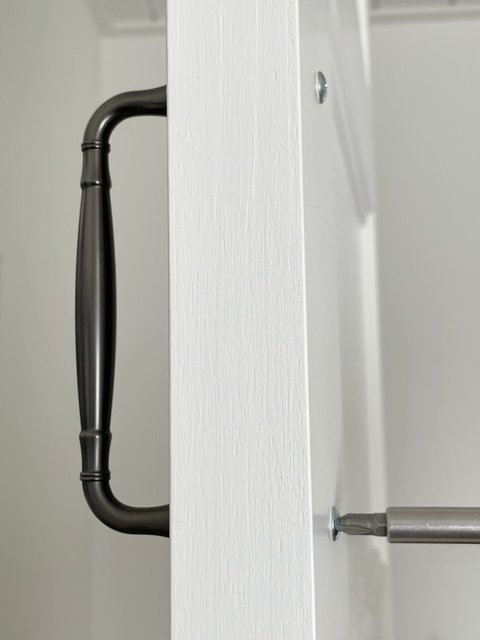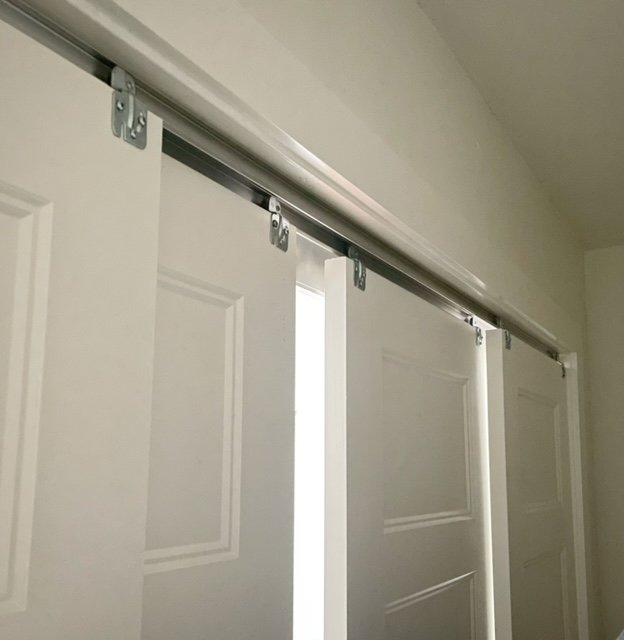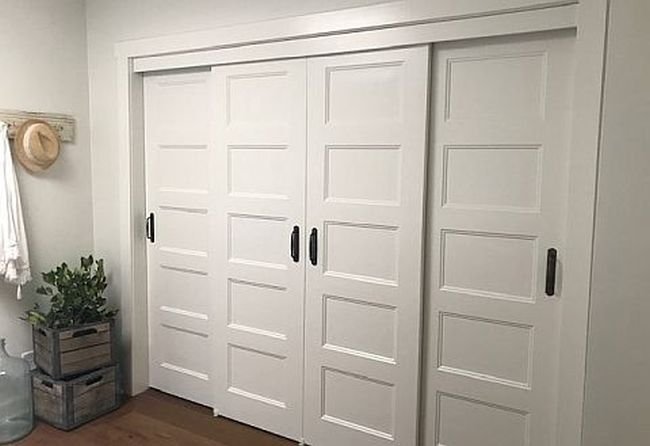Sliding Closet Doors
(this post contains affiliate links)
I get so many questions about our guest room sliding closet doors!
Pin for later
A few years ago,
I wrote a quick post about these doors that I thought wasn’t very exciting but it was kind of informative. (you can see the posts HERE and HERE)
And it blew up.
People wanted to know about my sliding closet doors.
To this day
they comment,
they email me questions,
they DM me with requests for more photos —
they want to know all about them.
Go figure…
I mean, really
sliding closet doors? (But I do think mine are special lol!)
So here I am again
talking about them
and this time
I’m going to answer all the questions about
HOW TO INSTALL SLIDING CLOSET DOORS
1. CALCULATE THE SIZE DOORS YOU WILL NEED
Our opening is 94 inches wide and each of our doors is 24 inches wide. The doors overlap about 1 inch. A general formula that I’ve seen is: Opening divided by the number of doors plus 1/2” equals the size door you need. So in our case, 94 (opening) divided by 4 (number of doors we want) + .5 = 24 (door size). I recommend that you lay the doors out on the floor with painter’s tape before you order them to be sure of the size.
QUICK TIP: We added a 2 x 4 on the left side to make our opening a little smaller so our doors would come out to be a standard size. It gets covered up by the trim so you never see it.
NOTE: You need to order door slabs for sliding closet doors. This means the doors will come without cutouts for doorknobs or hinges. Typically, bypass sliding closet door slabs will come with a cutout for a round or square hole that you insert a finger pull into so you can reach in and pull the door open or closed. This also allows the doors to bypass each other on all sides. If you want to mount door handles on the outside of the doors, be sure to order them without the cutouts. It also should be noted that if you use outside mounted handles, it will slightly limit the back doors from completely passing behind the front doors.
2. INSTALL YOUR TRACK
Cut your track to the exact length of the inside of your opening. Screw it to the top of the opening with the runners open to the back.
We installed ours 1.5 inches in from the front of the closet opening because I didn’t want it to be flush with the top of the opening.
3. INSTALL THE TRIM PIECE TO THE FRONT
Our track had a metal piece that came down across the front that we attached a 3-inch painted trim piece to. We just screwed it on from the back.
4. ATTACH THE HANGERS TO THE TOPS OF THE DOORS
Attach a hanger on each side of each door.
5. INSTALL THE HANDLES AND BACKPLATES
Install the backplates and handles centered on the middle section of the door.
This is also a comfortable height for us to reach the handles to open and close the doors.
6. HANG THE DOORS ONTO THE TRACK
From behind, lift each door onto the track making sure the doors in front have handles that meet in the center and the doors in the back have a left handle on the left and a right handle on the right.
Back of the doors from inside the closet
Loosen the hanger screws slightly to adjust them so that all the doors are plumb and even across the bottom.
7. ATTACH THE FLOOR GLIDES
Screw the floor glides to the floor making sure the middle one is centered on the two front doors where they meet and the two side glides are centered on the spot where the front and back doors overlap.
The front doors should glide easily through the front slot of each guide and the back doors should slide easily through the back slot of each glide.
And that’s how to install sliding closet doors!
I think the reason my doors are so popular is because they’re symmetrical. It’s way more common for a closet opening of this size to just have 3 larger doors on it.
But I think it’s way more appealing to have an even number of 4 smaller doors because it gives the closet balance.
Let me know what you think!
Pin for later
GET THE LOOK
As an Amazon Associate and rewardStyle affiliate, I may earn a small commission on qualifying purchases at no additional cost to you




















